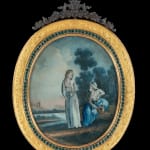Chinese Export Double-sided Glass Painting and Mirror
8 ¼ x 5 ¾ in
Further images
In the original gilt bronze and paste set frame with paste decoration, the reverse-painted image depicting Pomona and Vertumnus, the obverse with a mirror.
This image depicts the goddess Pomona - associated with fruit trees and fruitful bounty - and Vertumnus, who represents change, growth and the seasons. In Ovid’s Metamorphoses, their story tells of Vertumnus’ love for Pomona, who is interested only in her garden and shuns any suitors. To spend time with her in her garden and admire her beauty, Vertumnus disguises himself as a reaper, a shepherd, a fisherman and finally as an old woman, praising Pomona’s bountiful garden and kissing her. He admires a grapevine climbing up a tree and says that the vine needs the tree to support it; so, he argues, Pomona needs a mate and should marry. Still disguised, he recommends Vertumnus as a worthy suitor. He then reveals his true form and wins Pomona’s love.
There are a number of useful comparators for the composition of this image which date from the 17th and 18th centuries including a print after Boucher, c. 1765, 19.4 × 13.1 cm, MET Museum 17.3.1702 and an etching by Antonio Tempesta (Italian, Florence 1555–1630 Rome). dated, 1606, 10.4 × 11.5 cm, MET Museum 51.501.3993.
The contemporary dress of the figures in this glass painting can be compared to a drawing by Francesco Bartolozzi which shows Vertumnus in a mobcap and Pomona in an Empire line dress, (Vertumnus and Pomona, Francesco Bartolozzi, black and red chalk, 23.8cm diameter, one of a set of four, the others depicting Galatea, Venus and Vulcan and Boreas and Orithyia, c. 1797 , sold Christie's 5th March 1974, lot 145).
Whilst a direct original print source for this painting does not appear to be extant, it is worth noting that in ‘The Decorative Arts of the China Trade: Paintings, furnishings and exotic curiosities’, Carl L. Crossman comments that: ‘[b]y the 1780s the copying of English and European engravings had come into vogue’ (Antique Collectors’ Club, 1991, p.203). Such prints were most common in Europe during the 17th-19th centuries and were cheaply made and sold on street corners. They are now rare as they were considered disposable ephemera at the time. These prints would have formed the vast bulk of the images which reached China and were used as the basis for glass paintings which were exported to Europe.
As the reverse of this painting has a mirror, it is important to note that there is evidence that the story of Vertumnus and Pomona was considered an appropriate and desirable subject for the decoration of items used for a lady’s toilet. A box from a toilet set decorated with this subject can be found in the collection at the Victoria and Albert Museum and it is suggested that it would have been deemed suitable as a betrothal or wedding gift (accession no. 8506-1863).
Chinese mirror paintings: Reverse glass paintings were produced in Canton, for export to Europe during the 18th and early 19th Centuries, and the subject matter varied considerably depending on when they were executed during this period. The technique of ‘reverse’ painting was already well-known in Europe. In 1715 Jesuit missionary Father Castiglione arrived in Beijing and decorated the Imperial Garden, having won approval at the royal court under Emperor Yongzheng and Emperor Qianlong. He learned to paint in oils on glass and Chinese artists took up the technique which had not been used in China before Castiglione’s arrival.
Generally, the glass used for such pieces was imported from England, despite China’s long history of glassmaking. In Ancient China, glass was used as a substitute for jade – a material for making decorative objects. The Emperor Kangxi had established a glass workshop within the Forbidden City by 1696, which produced a large number of ritual utensils and ornaments, but no flat glass. Contemporary reports note that the Chinese attempts at making flat glass were frequently ‘thin and brittle’ in contrast to the ‘thick and crystal-like’ glass produced in the West, which led to sheets of clear and mirrored glass being exported to China.






